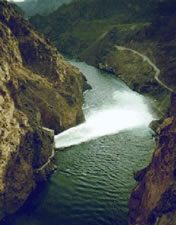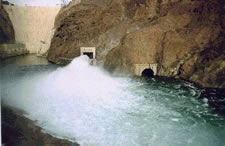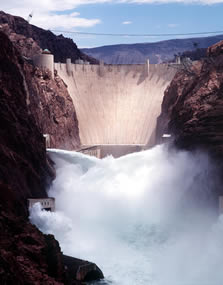Hoover Dam
Catching a Wave
Jet Flow Gate testing brings a crowd
 "Jet flow gate testing" doesn't sound like an
event that would bring reporters, cameramen, and news helicopters out to Hoover
Dam, located a fair distance from their regular news beats in downtown Las
Vegas. But in June, 1998, as a torrent of water sent whitecaps rippling down the
Colorado, the tests fascinated observers and garnered newspaper and television
coverage from several local media outlets.
"Jet flow gate testing" doesn't sound like an
event that would bring reporters, cameramen, and news helicopters out to Hoover
Dam, located a fair distance from their regular news beats in downtown Las
Vegas. But in June, 1998, as a torrent of water sent whitecaps rippling down the
Colorado, the tests fascinated observers and garnered newspaper and television
coverage from several local media outlets.
Twelve obsolete needle valves were replaced with new jet flow gates in the outlet works at Hoover Dam to meet criteria that require the dam to release 73,000 cubic feet per second without using the spillways. Previously, the outlet works had a release capacity of about 50,000 cubic feet per second (one cubic foot is 7.48 gallons).
 The jet flow gates are devices that are
designed to operate under high pressure. They include a steel plate that can be
raised or lowered to either prevent or allow water to be discharged from a
structure, much like the faucet in your sink controls the flow of water. The
eight gates in the lower valve houses are 68 inches in diameter and each is
capable of discharging approximately 3,800 cubic feet per second (28,424 gallons
per second) at the present lake elevation. When a gate is closed, the force of
the water behind it is 248 pounds per square inch, or 900,736 pounds per gate!
The four gates in the upper valve houses are 90 inches in diameter and each is
capable of discharging approximately 5,400 cubic feet per second (40,000 gallons
per second).
The jet flow gates are devices that are
designed to operate under high pressure. They include a steel plate that can be
raised or lowered to either prevent or allow water to be discharged from a
structure, much like the faucet in your sink controls the flow of water. The
eight gates in the lower valve houses are 68 inches in diameter and each is
capable of discharging approximately 3,800 cubic feet per second (28,424 gallons
per second) at the present lake elevation. When a gate is closed, the force of
the water behind it is 248 pounds per square inch, or 900,736 pounds per gate!
The four gates in the upper valve houses are 90 inches in diameter and each is
capable of discharging approximately 5,400 cubic feet per second (40,000 gallons
per second).
 The test was performed to obtain water release
data from the new jet flow gates and ensure there was no loss of efficiency to
the generators during their operation.
The test was performed to obtain water release
data from the new jet flow gates and ensure there was no loss of efficiency to
the generators during their operation.
The speed of the water coming out of each of the lower gates at maximum flow was calculated at 120 miles per hour! At maximum opening, each gate discharged about 28,424 gallons of water per second. That's enough water to fill the average backyard swimming pool in less than one second!
The upper gates are situated 180 feet above the river. Water from the gates shoots across the canyon to strike the wall on the other side. The water exits the gates at 120 feet per second, or 83 miles an hour. When all four upper gates are in operation they could fill an Olympic size swimming pool, 500,000 gallons, in three and a half seconds.
Source - U.S. Department of the Interior - Bureau of Reclamation